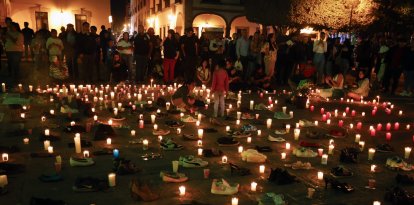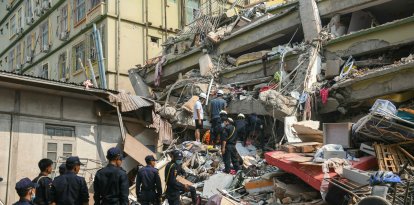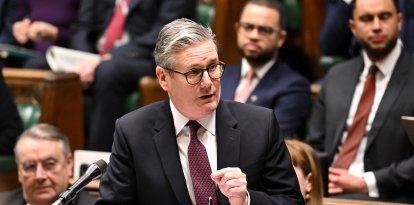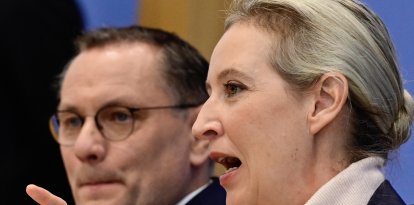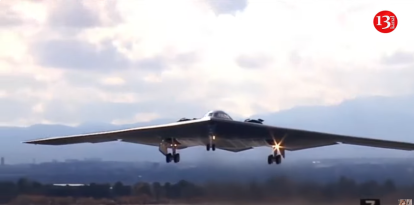Three keys to understanding the narcoterrorist crisis in Ecuador
The internalization of the armed conflict in Colombia, the consequences of the Correa pact and the Metastasis case. The South American country did not reach this breaking point overnight.

Ecuador en crisis de violencia por el narcoterrorismo / Galo Paguay / AFP
Ecuador is experiencing one of its darkest episodes so far this century. Between January 8 and 9, narcoterrorism declared war on the country, taking over prisons, universities and the media. These events occurred in the first few days of 2024, with 2023 closing out the most violent year in the history of the South American country.
The videos are terrible. Civilians were kidnapped, injured, and killed. Members of the security forces were executed in cold blood by criminals. The gang members are committing violent acts without batting an eye, and the president, Daniel Noboa, finally acted by declaring “Internal Armed Conflict.”
All of this happens just hours after Adolfo Macías, alias “Fito,” mysteriously escaped from a prison in Ecuador, prompting President Noboa to declare a state of emergency. He is the leader of the Los Choneros gang, one of the most dangerous criminal gangs in Ecuador.
But how did Ecuador get to this point? Was it a sudden event or something that developed over the years? Here are some keys to understanding it.
“Peace” in Colombia was costly for Ecuador
In an interview with Voz Media, Juan Martin Salvador, an Ecuadorian analyst who works for the think tank Towards Asia Pacific, explained that Ecuador was, for a long time, an “island of peace” amid historically violent countries such as Peru and Colombia, especially after in the 1980s former President León Febres-Cordero put an end to the recently formed Ecuadorian Marxist guerrillas.
However, between 2000 and 2005, when the “Plan Colombia” and other security policies operated, various Colombian criminal groups began to take refuge in Ecuador due to the successful efforts of former presidents Andrés Pastrana and Álvaro Uribe Vélez. The situation increased, especially after the controversial “Peace Agreements” between the Colombian state and the armed guerrillas.
The consequences for Ecuador were disastrous; in fact, several studies collected the phenomenon of the internationalization of the Colombian conflict.
First, Ecuador’s border with Colombia became a militarized time bomb, with Marxist armed groups such as the FARC and the National Liberation Army (ELN) operating within its borders.
Second, it became a volatile area prone to conflict due to the impressive amount of coca crops, trafficking and drug trade, according to a BBC report in 2018.
Over time, drug production and trade made Ecuador stop being a transit country and become a drug distribution center for all of Latin America, thanks to the participation not only of Colombian criminal groups but also of the entire region, including Mexican cartels.
Correa’s false peace
The socialist Rafael Correa became President of Ecuador in 2007 as an outsider. However, the label did not last long, as he soon aligned himself with the late Venezuelan socialist leader Hugo Chávez, forming part of the controversial Marxist organization Foro de Sao Paulo.
But Correa, a middle-class man who did not have the resources to finance a presidential campaign, did not come to power alone.
According to Jorge Briceño, a FARC leader known as “Mono Jojoy,” Correa rose to the presidency financed by the guerrilla group. Likewise, many press reports denounce that Correa received dirty money from Chavismo for his two presidential campaigns.
Although Correa denies links with the FARC, the former socialist president cannot deny his “false peace” pact with criminal gangs.
Martin Salvador explains that, during Correa’s first government, after a change in the constitution, Ecuador eliminated the United States military base in the South American country that served to keep drug trafficking groups at bay. Over time, a “pacification” agreement was also reached that led to the “legalization” of Ecuadorian gangs.
Although the international media described the unprecedented Ecuadorian plan as successful, as a result of the low homicide rates under the Correa government, the reality, according to Martin Salvador and other critics, is that criminal gangs in the South American country never stopped committing crimes. Furthermore, they grew stronger over the years under the complicit gaze of the state.
When Correa left power, it was a matter of time before “peace” was torn down like a house of cards.

Correa would have remained in power for a long time had it not been for “the betrayal” of Lenin Moreno, his vice president, but he categorically distanced himself from Correism and became president in 2017.
Without grief or glory, Lenin left the Government Palace in 2021, and Guillermo Lasso assumed the country’s reins.
It was with Lasso that crime began to skyrocket just after the former president decided, as he stated, not to negotiate with the gangs. Consequently, the pact was broken.
“Paradoxically, Lasso was the first president of Ecuador in the last fifteen years not to negotiate with criminals, but even so, there was a general image that he was soft on security,” analyst Martin Salvador told Voz Media in a call.
For a long time, local media accused Lasso of having agreed with the gangs; however, the numbers show that his government was one of those that seized the most drugs in the world. Under his management, crime also began to flourish: the rates of robberies, kidnappings, shootings and murders began to rise as a result of disputes between gangs and fueled by the collateral effects of the pandemic. In short, it was a clear symptom that “peace” was finally over.
Narcopolitics: what the “Metastasis case” taught
In August 2023, the journalist, parliamentarian and presidential candidate Fernando Villavicencio was murdered at a political rally in Quito, the Ecuadorian capital.
Under the motto “It is time for the brave,” Villavicencio forged a political career denouncing the acts of corruption of former President Correa and the strengthening of narcoterrorism in Ecuador. One of his investigative works led to Correa being tried and sentenced to eight years in prison.
With his murder, it became clear that Ecuador was deeply immersed in narcopolitics. However, the harshest proof of this key fact lies in the now famous “Metastasis case,” revealed by the courageous Attorney General Diana Salazar Méndez.
Last December, Ecuadorian authorities carried out dozens of raids in seven of the country’s 24 provinces. The result was impressive: 29 people were arrested, including judges, prosecutors, police officers, lawyers and individuals related to organized crime.
Wilman Terán, president of the Judiciary Council, a state body overseeing the judicial function, was detained due to the operation. Officials searched his residence, and $25,000 in cash was found in $20 and $100 bills.
In the Metastasis case, the Prosecutor’s Office mainly investigates the existence of an alleged corruption structure at the service of drug trafficker Leandro Norero, who was murdered in October 2022 in the Cotopaxi Prison, an event that led to a great wave of violence for three days. in the prison facility that left 30 dead and more than 60 injured.
The investigation, in short, shows how drug trafficking infiltrated justice and security in Ecuador, as explained by Salazar Méndez.
“The Metastasis case is an x-ray of how drug trafficking has taken over State institutions to, through ill-gotten money, operate from judicial and political bodies and achieve impunity in some cases,” said the prosecutor.
During the case, the telephone number of Norero, also known as “El Patrón,” was obtained; who was one of the leading financial suppliers of the gangs Los Lobos, Los Tiguerones and Los Chone Killers, an armed organization that Norero himself created.
Chats were discovered on his cell phone that show how Norero manipulated the system through bribes to judges, police officers and lawyers who protected the drug trafficker so that he could evade justice for years.
“Prosecutor Salazar assured that the network operated at least between May and October 2022 and that the officials received bribes of between 6,000 and 450,000 dollars, in addition to jewelry and real estate, in exchange for the criminal group receiving judicial dismissals, advice, administrative benefits and favorable legal resources for Norero, his brothers and wife,” reported the newspaper La Tercera.
The protection that Norero received occurred in the context of political unrest and unprecedented violence in Ecuador.
Now, just a few weeks after the Metastasis case was unearthed, Ecuador finds itself mired in a war between strengthened narcoterrorists and a state that needs to regain control of the prisons and also of its institutions plagued by bad apples.
RECOMMENDATION

